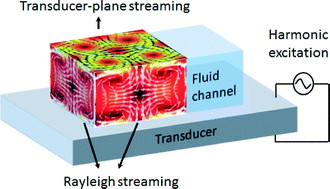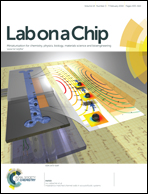Numerical simulation of 3D boundary-driven acoustic streaming in microfluidic devices†
Abstract
This article discusses three-dimensional (3D) boundary-driven streaming in acoustofluidic devices. Firstly, the 3D Rayleigh streaming pattern in a microchannel is simulated and its effect on the movement of microparticles of various sizes is demonstrated. The results obtained from this model show good comparisons with 3D experimental visualisations and demonstrate the fully 3D nature of the acoustic streaming field and the associated acoustophoretic motion of microparticles in acoustofluidic devices. This method is then applied to another acoustofluidic device in order to gain insights into an unusual in-plane streaming pattern. The origin of this streaming has not been fully described and its characteristics cannot be explained from the classical theory of Rayleigh streaming. The simulated in-plane streaming pattern was in good agreement with the experimental visualisation. The mechanism behind it is shown to be related to the active sound intensity field, which supports our previous findings on the mechanism of the in-plane acoustic streaming pattern visualised and modelled in a thin-layered capillary device.


 Please wait while we load your content...
Please wait while we load your content...